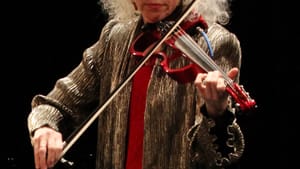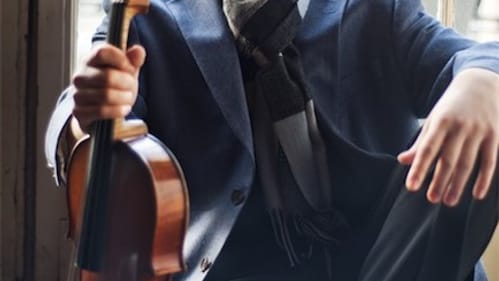Stay in the Loop
BSR publishes on a weekly schedule, with an email newsletter every Wednesday and Thursday morning. There’s no paywall, and subscribing is always free.
Innovative improvisations
Chamber Orchestra of Philadelphia presents 'Mozart, Mooke, and Fauré'

After this weekend’s Chamber Orchestra of Philadelphia concert, internationally acclaimed violist Born Lau noted, “It takes a lot of courage to put two viola soloists on the same program!” That was the least of the surprises that challenged and delighted audiences in this season’s Improvisionaries series.
Lau joined the orchestra, led by conductor Dirk Brossé, in Hummel’s Fantasie for Viola and Orchestra. He added a twist of his own: a charming improvisation paying homage to composers ranging from Mozart to John Williams.
Lau’s artistry took advantage of the Perelman Theater’s acoustics, which favor the warm, rich sound palette of the viola and its lower-voiced cousins. Hummel was a master who studied and lived with Mozart, and joined Beethoven in bridging the gap between classical and Romantic perspectives.
An electric world premiere
Another treat for audiences attracted to the orchestra’s audacious programming was the world premiere of Martha Mooke’s “Invisible Hands” for electric viola and orchestra. The title refers to a statement by mythologist Joseph Campbell that he often felt he was held up and supported by “hidden hands”: spiritual guides and protectors. Mooke is the second violist Lau referred to, and proof that though Women’s History Month may be past, the ways women composers are reinventing classical music is only just beginning.
Mooke has toured and performed with Barbra Streisand, Patti Smith, and other major artists, and founded the Scorchio Quartet featured on David Bowie’s Heathen album. But the impact of her music, not her celebrity associations, is what makes Mooke a force to be reckoned with.
Brossé programmed “Invisible Hands” in two parts of the program: just before intermission, in a version for full orchestra, and again as the last work following Fauré’s Pelléas et Mélisande. Wearing a long white duster, arms bared, Mooke improvised on electric viola and operated three electronic foot pedals (multi-effects, volume, and loop station). The smooth viola line glided over the orchestra, which played the same score as in part one, while the electronic ambience created an amorphous cushion of sound.

At one point, Brossé left the podium as Mooke strolled through the orchestra, stopping to “converse” musically with several players, who were challenged to respond with improvised music of their own. It had a kind of ‘70s “happening” feel, but updated, with new technology and a down-home attitude.
In conversation after the concert, Brossé and Mooke described the process of continuously refining and tailoring the work right up to the last minute. When I asked Mooke if a recording would be available to the public, she admitted that this type of music needs to be experienced live — but seemed to be thinking it over.
I hope recordings of this type of new music will be available in the future, since great improvisers of the past — think John Coltrane and Ali Akbar Khan, not to mention the aleatoric composers, such as John Cage (played by the orchestra earlier this season) — have left us such a dazzling recorded legacy.
Freehand conducting
The concert began with Mozart’s Symphony No. 38, the “Prague,” a stately, inventive work composed in 1786. What a smooth, delicious concoction this was — three movements of pure delight. The Chamber Orchestra has such a grand, enveloping sound, larger than its small size would suggest.
Using no baton, Brossé threw himself into the music and seemed to draw out the sound, reflecting it back into the audience. The result was clean and precise without being cold or mechanical.
Special mention goes to the penetrating clarity of the woodwinds: Edward Schultz, principal flute; Geoffrey Deemer, principal oboe; Doris Hall-Gulati, principal clarinet; Michelle Rosen, principal bassoon; and Karen Schubert, acting principal French horn.
Schultz’s evocative flute playing, paired with the beauty of Sophie Bruno Labriner’s harp obbligato, brought fresh insight to the well-known “Sicilienne” from Fauré’s suite on the second half of the program. Bucolic, pastoral, and serene, the suite was the perfect complement to a sometimes grand, often brilliant, and unfailingly adventurous program.
What, When, Where
Mozart, Mooke, and Fauré. Martha Mooke, electric viola; Born Lau, viola; Dirk Brossé, conductor. Chamber Orchestra of Philadelphia. Symphony No. 38 in D major, K. 504, “Prague,” by Wolfgang Mozart; Fantasie for Viola and Orchestra, Op. 94, by Johann Nepomuk Hummel; "Invisible Hands" (Versions I and II), by Martha Mooke; Pelléas et Mélisande Suite, by Gabriel Fauré. April 1-2, 2018, at the Kimmel Center's Perelman Theater, 300 S. Broad Street, Philadelphia. (215) 545-5451 or chamberorchestra.org.
Sign up for our newsletter
All of the week's new articles, all in one place. Sign up for the free weekly BSR newsletters, and don't miss a conversation.
 Linda Holt
Linda Holt